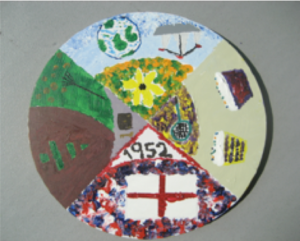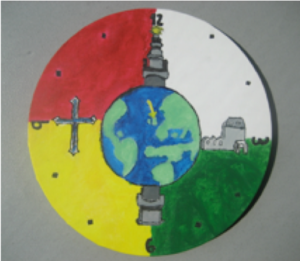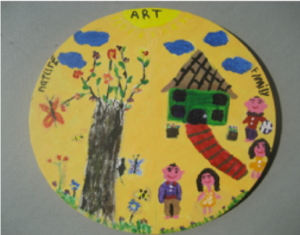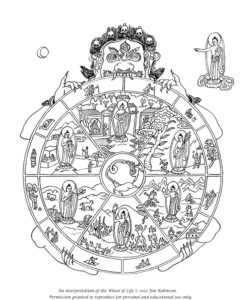An investigation into Sikh belief about God through a study of the Mool Mantar, the Enlightenment of Guru Nanak and the Ik Onkar symbol.
For KS2 pupils. Originally written by Gemma Kingston, updated in April 2019.
Key words and concepts
Amrit: Literally ‘Nectar’. A drink made from sugar dissolved in water and stirred with a sword – drunk during special ceremonies. Considered to be divine.
Guru: ‘Teacher’. The name given to the ten great human teachers of Sikhism and also to the Sikh holy book.
Guru Granth Sahib: The Sikh scripture. The tenth Guru, Guru Gobind Singh declared that there would be no other living Gurus after him, so instead Sikhs could look to their holy scriptures for guidance, so the holy book became the ‘Guru.’ It is a collection of teachings and writings by Guru Nanak and other Gurus as well as Sikh, Hindu and Muslim saints. These scriptures are written in Punjabi and are greatly respected by all Sikhs as the living word of God. The book is given the same respect as a human Guru.
Guru Nanak: The Sikh faith was founded by Guru Nanak (1469-1539) and shaped by his nine successors in the sixteenth and seventeenth centuries in South Asia.
Gurdwara: a Sikh place of worship. Any building where the Guru Granth Sahib is kept is a Sikh place of worship. It is called the Gurdwara (‘Gateway to the Guru’). A focal point for the communitu.
Ik Onkar: pronounced ‘Ik O-an-kaar’. Design which represents the statement of faith ‘There is only one God’. The first phrase of the Mool Mantar. It is also used as a symbol to decorate Sikh objects. Punjabi – Found on turban badges.
Khalsa: The brotherhood of Sikhs, founded by the tenth Guru, Guru Gobind Singh.
Monotheist: someone who believes in one God.
Mool Mantar: Basic teaching; essential teaching. The basic statement of belief at the beginning of the Guru Granth Sahib. The first hymn composed by Guru Nanak.
Punjab: ‘Land of Five Rivers’. The northern region of India where Sikhism originates from.
Sikh: The word ‘Sikh’ in the Punjabi language means ‘disciple’, Sikhs are the disciples of God who follow the writings and teachings of the Ten Sikh Gurus.
Sikhism: Sikhism is founded upon the life and teaching of Guru Nanak Dev Ji and nine successive gurus who lived in the northern part of South Asia between the fifteenth and eighteenth centuries. Sikhism is a worldwide religion with nearly 30 million adherents which is about 1% of the world’s population.
Waheguru: Wonderful Lord. A Sikh name for God.
Learning activities
You will need:
- the Ik Onkar symbol (shown below), images of Sikh artefacts bearing this symbol.

- A virtual tour of the Gurdwara, or images of a Gurdwara’s various areas.
- An audio file or video of the Mool Mantar, the Sikh prayer, as well as an image of the prayer in the Gurumurkhi script.
- Images and information about the Kara- one of the 5 K’s (a bangle).
- Information about Sarika Watkins-Singh, suspended for wearing her Kara to school.
ENQUIRE.Show the pupils a selection of images showing artefacts decorated with the Ik Onkar symbol, such as the below, and give them a chance to look carefully at the artefacts and notice anything each item has in common. Ask questions about the objects, their purpose and significance. Do they notice the symbol which appears in each?
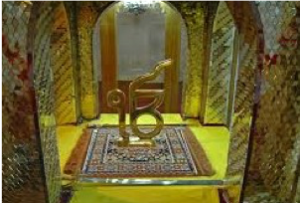


Draw the pupils’ attention to the Ik Onkar Explain this is an important Sikh symbol which can be seen in many places such as badges, on the walls of a gurdwara and in the home.
Show pupils a selection of symbols from other religious traditions, such as the Jewish Star of David or the Christian cross. Ask pupils to suggest (a) what such symbols communicate to believers, and (b) how believers might use these symbols to show their beliefs. Encourage them to make a record of their answers.
Show pupils the Mool Mantar (sometimes written Mool Mantra) – see below – and ask if they can spot the symbol in the writing: can they work out from the translation what the symbol means? Explain that the first words of the Mool Mantar are ‘Ik Onkar’ meaning ‘there is one God’ and that the symbol acts as a visual reminder to Sikhs of what they believe about God and his oneness (monotheism).
Ask the pupils to design another object that includes the Ik Onkar symbol which would be for Sikhs a constant reminder of God’s oneness.
EXPLORE – A PLACE OF WORSHIP (GURDWARA). Explain the role of the Gurdwara in the Sikh community, perhaps by reading the relevant section of a text book on Sikhism. Point out that the Gurdwara is a focal point for the Sikh community and that it is open to all: it is a place of equality and sharing.
If it is not possible to take pupils to a gurdwara, take them through the virtual tour of a Gurdwara via an online video tour. Ask pupils to look carefully for any Ik Onkar symbols. Encourage pupils to reflect on their significance and ask them to suggest how attending the Gurdwara might inspire Sikhs to treat other people in a kind way. Encourage them to note down their reflections and to say what visits they have made that have inspired them.
EXPLORE – SIKH TEXT. Together with pupils, read the translation of the Mool Mantar – see below. Show the Mool Mantar in its original script (Gurmukhi – the script in which the Punjabi language is written).
Explain that the Mool Mantar means ‘basic teaching’ and is found at the beginning of every section of the Guru Granth Sahib. It is very much like a Sikh creed, the ‘essence’ of the teachings, repeated each day during early morning prayer.
The Mool Mantar – basic teaching
| Words | Meaning |
| IK Onkar | There is only one God |
| Sat Nam | Eternal truth is His name |
| Karta Purakh | He is the creator |
| Nir Bhau | He is without fear |
| Nir Vair | He is without hate |
| Akal Murat | Immortal, without form |
| Ajuni | Beyond birth and death |
| Saibhang | He is the enlightener |
| Gur Prasaad | He can be reached through the mercy and grace of the true guru |
Encourage pupils to memorise the first few lines and ask them why Sikhs might memorise the whole Mool Mantar. Point out that most Sikhs will have heard the Mool Mantar said and sung very many times since they were young and that it contains many teachings that reveal what God is like in Sikh belief.
Ask pupils to work in pairs to come up with two questions to ask a Sikh about the Mool Mantar, especially focusing on what it might mean to that particular Sikh believer, and to the wider community. Ask them then to meet with another pair and to see if they can imagine what a Sikh might say in answer to each other’s questions.
Set pupils the challenge of defining the words ‘eternal,’ ‘immortal,’ and ‘enlightened.’ Ask them to use a dictionary to define them and then (a) to use them as a Sikh would to describe God and (b) to use modelling clay to create a new symbol to represent each of these terms, or any other from the Mool Mantar. Encourage them to take photos and then to write or audio-record their thoughts as to the meaning of their creations. The results could go into a class or online book about the Mool Mantar.
EXPLORE – Guru Nanak. Show an image of Guru Nanak that includes the Ik Onkar. and ask pupils to identify him. Point out the symbol if they have not noticed it. Explain briefly who Guru Nanak is and that the Mool Mantar is believed to be the first thing said by Guru Nanak upon his enlightenment at the age of about 30.
At a time in India when Muslims and Hindus were in conflict, Guru Nanak said ‘there is no Hindu, there is no Muslim’. Ask pupils to suggest what this reveals about what Sikhs believe to be the nature of God, and how Sikhs believe Waheguru is the same God worshipped by all other religions. Ask pupils for their reflections on the idea that there might be One God for all humanity which different people call different names. What other names do the pupils know? (Allah, God, Yahweh, etc.). Explain that not all people (a) believe in God and (b) believe that all religions worship the same God. Can they give examples and suggest reasons for such differences of opinion and belief?
EXPLORE – SIKH LIVING. Show the pupils a range of Sikh artefacts. Focus on the Sikh Kara. Ask pupils to suggest why a Sikh might wear the Kara: what might it mean and symbolise? What might it communicate about the nature of God? For those who need more support, ask what a circle could represent about God?
Explain that the kara is a bangle, usually made from iron or steel and worn on the right wrist. The steel is a symbol of strength, and the circular shape is a symbol of unity and eternity – a circle has no beginning and no end. This reflects the Sikh view of God who is eternal and infinite. The circular shape also stands for unity between Sikhs and between Sikhs and God. It is another representation of Sikh belief in one God, a symbol of God having no beginning or end. It keeps a Sikh focused and close to God.
Look at different styles of Kara available online for Sikhs to buy, with the choice of sacred text from the Guru Granth Sahib engraved on them. Ask them to report back to the class on the type of karas available to Sikhs and to work together to design their own style, based on what they have seen. [Remind pupils of the need to consider websites thoughtfully: what is this website trying to say or do? Who put the material up there and why?]
In role, encourage them to write a sales pitch to a Sikh customer. Their report should include how the bracelet will make a Sikh feel closer to God and what it will remind them about the nature of God. [Pupils could also produce packaging and a card to be sold with the bracelet.]

Explain that Sikhs believe that God doesn’t exist just in the sky or heaven but is present everywhere and lives within the human heart and within all living beings and life. That is one reason why they use the term ‘Waheguru’. Encourage pupils to reflect on the meaning of the word ‘God’ and ask them whether they think the concept of ‘God’ in Sikhism is very different from other beliefs about God. Do they think that God is ‘he’ or ‘she’ or beyond gender? Explain that most religions that believe in God often refer to God using the male pronoun, but that most of them believe that God is beyond gender. This is certainly the case in Sikh teaching.
Use the statements below to prompt deeper thinking. Show pupils the following statements, ask them to reflect upon each in turn and to offer suggestions as to the meaning:
- The Guru Granth Sahib says of God: ‘One Light fills all creation. That Light is You.’ I wonder… what does this mean?
- Sikhs believe that ‘the Creator is in the creation and the creation is in the Creator.’ I wonder… what does this mean?
- Sikhs believe that ‘God is neither male nor female but instead a spirit that spreads across the universe.’ He is like ‘the fragrance within a flower’ (Guru Granth Sahib). I wonder… what does this mean?
As pupils offer their thoughts, encourage reflection on the inspiration given to Sikhs by the statements, and comparison with other world views.
With pupils, read about Sarika Watkins-Singh, who at the age of 14 was suspended twice from school for wearing her Kara until a high court judgement allowed her to wear it.

What are arguments for and against Sarika’s actions? Ask pupils which arguments they find most persuasive and why. Ask them to consider that if school rules say no jewellery in school, would it be ok to wear jewellery if it is a religious symbol?
Hold a class debate.
